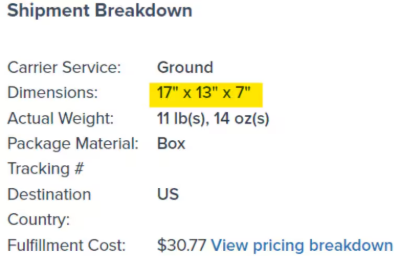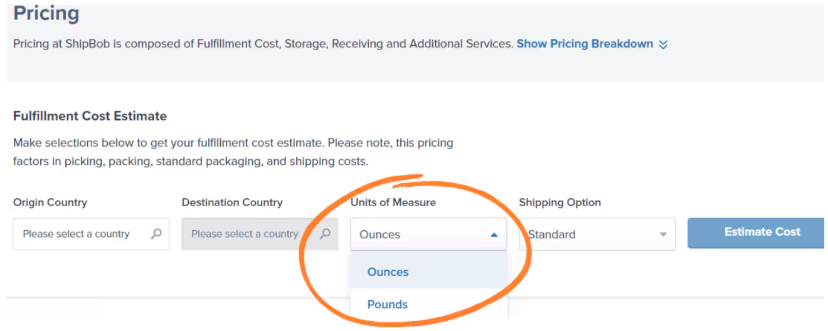Dimensional weight is a pricing technique used by carriers to account for both the weight and size of a shipment. Understanding how DIM weight works helps you accurately estimate shipping costs and optimize your packaging strategy. This guide explains the formula, key components, regional variations, and step-by-step calculations.
What is Dimensional Weight?
Dimensional weight (DIM) is a pricing method used for commercial freight transfer, including courier and postal services, that considers both a shipment’s actual weight and the space it occupies during transit. Carriers use DIM weight to ensure that charges reflect the amount of room a package takes up, which is especially useful for lightweight but bulky items. Jetpack calculates the order’s DIM weight (with the exception of US domestic shipments under 1 lb) and compares it to the actual weight. The larger of the two weights is used to determine the fulfillment cost.Key Components of Dimensional Weight
Understanding these four components is essential for calculating DIM weight accurately:| Component | Description |
|---|---|
| Dimensions | The length, width, and height of the packaging, as shown in the Jetpack dashboard under the Shipment Breakdown |
| DIM Divisor | A value (cubic inches per pound) that varies based on the shipment type and fulfillment center location |
| Rounding | When calculating DIM weight, carriers require rounding up to the nearest whole number |
| Units of Measure | The Jetpack dashboard uses inches and pounds. When estimating actual weight, include the weight of dunnage and packaging materials, not just the product |
DIM Divisor by Region and Shipment Type
The DIM divisor varies based on where your shipment originates and its destination. Use this table to identify the correct divisor for your shipments:| Region | Shipment Type | DIM Divisor | When DIM Weight Applies |
|---|---|---|---|
| United States | US Domestic | 166 |
|
| United States | US to International | 139 |
|
| Australia | Domestic and International | 110 |
|
| Canada, EU, UK | Domestic and International | 139 |
|
Steps for Calculating DIM Weight
Follow these steps to calculate dimensional weight for your shipments:1
Review the chart and identify your DIM divisor
Check the DIM Divisor by Region table above to determine if your shipment is subject to DIM weight pricing and note the appropriate DIM divisor.Exception: US domestic shipments under 1 lb (0.45 kg) are always billed based on their actual weight. If the shipment type is not subject to DIM weight, use your pricing plan based on the actual weight.
2
Gather shipment dimensions
Locate the shipment’s length, width, and height from the Shipment Breakdown in the Jetpack dashboard.

3
Calculate the cubic size
Multiply the dimensions to find the cubic size:Formula: Cubic Size = Length × Width × HeightExample: For a shipment measuring 17” × 13” × 7”:17 × 13 × 7 = 1,547 cubic inches
4
Compute the DIM weight
Divide the cubic size by the DIM divisor for your region:Formula: DIM Weight = Cubic Size ÷ DIM DivisorExample: With a cubic size of 1,547 cubic inches and a DIM divisor of 166 (for US domestic shipments):1,547 ÷ 166 = approximately 10 pounds or 160 ounces
If your pricing plan uses ounces by default and you prefer pounds, adjust the units accordingly in your dashboard.

5
Convert to ounces (optional)
If needed, multiply the DIM weight (in pounds) by 16 to convert it to ounces.Example: 10 pounds × 16 = 160 ounces
Understanding the Formula
The dimensional weight formula ensures carriers charge appropriately for both weight and space: DIM Weight = (Length × Width × Height) ÷ DIM Divisor
- Cubic Size: 17 × 13 × 7 = 1,547 cubic inches
- DIM Divisor: 166 (US domestic)
- DIM Weight: 1,547 ÷ 166 = 9.3 pounds → rounds up to 10 pounds
- Actual Weight: 3 pounds
- Billable Weight: 10 pounds (DIM weight is higher, so it’s used for billing)
Let’s Dive Deeper
Package Size and Weight Policies
Understand carrier restrictions and packaging guidelines
Packaging + Shipping Fragile Items
Learn how to package items safely while managing size
Standard Packaging
Explore packaging options that affect dimensional weight
Controlling Processing Speed
Manage order fulfillment timing and priorities
General Pricing
Review how dimensional weight affects your fulfillment costs
Tools & Techniques Overview
Back to the main tools guide
Questions? Contact Jetpack Care.
If you have questions about your dimensional weight calculation, please use the chat feature in your Jetpack dashboard or contact Jetpack Care for further support. Our team is always here to assist via Slack, phone, or email!